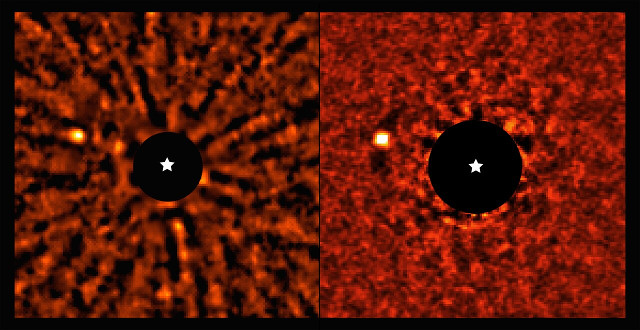
An article published in “Astrophysical Journal Letters” reports the role of the astrometric technique in the discovery of one of the least massive planets so far photographed directly. A team of researchers used the Keck II telescope at the Keck Observatory in Hawaii to photograph the exoplanet cataloged AF Lep b, among the first discovered using the technique of astrometry, which is usually used in conjunction with other astronomical investigation methods. This offers new perspectives in the search for exoplanets.
The top image (Courtesy Kyle Franson, University of Texas at Austin/W. M. Keck Observatory. All rights reserved) shows the movement of exoplanet AF Lep b, identified in the white spot near the arrows, in images captured in December 2021 and February 2023. The dashed line indicates the extent of Jupiter’s orbit as a reference for the planet’s distance from its star.
For over twenty years now, astronomers have been discovering exoplanets with a series of increasingly refined techniques and increasingly sophisticated instruments. The technique of astrometric is based on the observation of small periodic oscillations in the movement of stars caused by the gravitational influence of the planets that orbit them. The problem is that usually, these wobbles are so subtle that the best available telescopes are unable to provide precise enough measurements. For this reason, this technique is generally used together with others but some researchers tried to exploit it without help.
A study of the star AF Leporis, or simply AF Lep, made it possible to discover a gas giant planet using only astrometry. The young star AF Leporis, almost 90 light-years away from Earth, was chosen as a candidate by examining the movements observed over 25 years during the Hypparcos and Gaia missions, which showed oscillations that suggested the presence of at least one planet around it.
Some instruments are capable of capturing direct images of exoplanets but so far, only a tiny minority of the thousands of exoplanets discovered were photographed. At Keck Observatory, it was observed using Near-Infrared Camera 2 (NIRC2) with its coronagraph blocking the star’s light. The result is the capture of the image of a gas giant exoplanet with a mass estimated, still roughly, at about 5 times Jupiter’s.
The discovery of the exoplanet AF Lep b was already reported by other researchers in two articles, available here and here, published in the journal “Astronomy & Astrophysics” in April 2023. In that case, the planet was photographed using the SPHERE instrument mounted on ESO’s VLT in Chile. The study based on the image captured at the Keck Observatory in Hawaii stresses the importance of the technique of astrometry in selecting candidates for the search for exoplanets.
Now AF Lep b is among the few exoplanets photographed directly, and in this case with two different instruments, a remarkable success for the application of the astrometric technique together with direct imaging. According to the Keck Observatory’s press release, this marked the beginning of a new era in exoplanet discovery. It’s a useful technique in searching for planets that are far from their stars and therefore difficult to discover using other methods.


